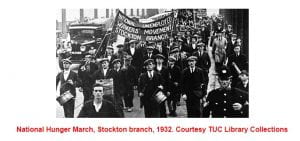Just a few days ago I wrote about a photograph of the Stockton branch of the NUWM – see https://foxburg.edublogs.org/2020/08/14/the-stockton-branch/
I ended with :
However we are left with a mystery: if the Stockton Contingent marched across the Tyne Bridge, with the Sunderland Branch behind them, why does the Itinerary of the 1934 Hunger March, taken from the Manifesto of the National Hunger March and Congress say:
‘TEES-SIDE CONTINGENT. Mobilise at STOCKTON-ON-TEES on February 2nd. JOIN TYNESIDE CONTINGENT at DARLINGTON on February 3rd.
I have just found a solution to the mystery, reading Kevin Shepherd’s Autobiographical reflections I found a reference to the image
I am happy with this, for it explains the anomaly, I was incorrect, this is not the 1934 march, but is the 1932 march. I have evidence that the 1932 march itinerary was likely to be used for the 1934 march.
 As you can see the Newcastle contingent was joined by 90 men and boys from Teesside. I suggest that the tone of the letter suggests that the organiser was not too happy about these joining, and therefore two years later they attempted to ensure there was no repetition; however as Johnny Longstaff shows they were not totally successful. The 1932 march is also distinguished by the Women’s contingent.
As you can see the Newcastle contingent was joined by 90 men and boys from Teesside. I suggest that the tone of the letter suggests that the organiser was not too happy about these joining, and therefore two years later they attempted to ensure there was no repetition; however as Johnny Longstaff shows they were not totally successful. The 1932 march is also distinguished by the Women’s contingent.
In a recorded interview George and Phyllis Short talk about their participation in the 1932 march. In all eighteen contingents converged on London’s Hyde Park on 27th October 1932, where the 3,000 marchers were met by a crowd of between 50, 000 or 150, 000 depending upon which source you use; in contrast the famous ‘Jarrow Crusade’ in 1936 had 100 marchers who also ended at Hyde Park, there was no official rally at the end, instead they joined a 5,000 strong Communist rally that was taking place.
The Metropolitan police commissioner deployed 70, 000 police officers to control the crowd in 1932, the aim was to prevent the petition the men carried reaching Parliament; when the Police confiscated the Parliamentary petition in Hyde Park violence broke out. In scenes reminiscent of Peterloo mounted officers charged the huge crowd which contained women and children, resulting in 75 people being seriously injured. Of interest we find that the British Union of Fascists was founded as the NUWM marched to London.
The NUWM leader Walter Hannington was arrested in Hyde Park, refused bail he spent several months in jail. He tried to prosecute the Home Secretary Lord Trenchard for illegally breaking into the NUWM’s London offices, the Police broke in and destroyed the contents, this was whilst Hannington was imprisoned. The Prime Minister, Ramsey MacDonald, personally intervened to prevent the prosecution of Lord Trenchard going ahead.
My interest in the 1932 march, however is not because of the violence that ended it, but rather the 26 strong Woman’s Contingent, as mentioned Phyllis Short was part of the Women’s Contingent . We know the names of two other members of this contingent: the leader Maud Brown and of special interest to me, Maggie Airey from Chopwell.
I am grateful to Bernadette Hyland for her work on Maud Brown – see Celebrate IWD; Maud Brown and the Hunger Marches . I contacted Bernadette to enquire if she had any additional information, her response was swift and gracious, Maud is a fascinating character, she can be seen leading the contingent in this image.
 However my focus is on Phyllis and Maggie, and so, as ever, I have now set myself another task. I aim to identify both Phyllis and Maggie in the photographs of the Women’s section. Unfortunately we have no images of them from the 1930s, there is one of Phyllis in her 80s. I know it won’t be a swift process and indeed may fail, but I feel it will be as rewarding as my aim to identify the location of the Stockton NUWM photograph.
However my focus is on Phyllis and Maggie, and so, as ever, I have now set myself another task. I aim to identify both Phyllis and Maggie in the photographs of the Women’s section. Unfortunately we have no images of them from the 1930s, there is one of Phyllis in her 80s. I know it won’t be a swift process and indeed may fail, but I feel it will be as rewarding as my aim to identify the location of the Stockton NUWM photograph.
We know a fair amount about Phyllis’ work for Women’s rights after the Second World War; Rosie Serdiville and I have plans to write about this further. I have already written about Maggie Airey; an article was published in ¡NO PASARÁN! the IBMT magazine. Maggie’s sweet-heart was Wilf Jobling, it fell to Charlie Woods the Communist Party district secretary to tell his niece, Maggie that Wilf had been killed fighting with the British Battalion at Jarama. Charlie himself had taken part in the 1934 Hunger March alongside Wilf. Rosie and I also intend to write Maggie’s story.
My interest in the image of the Stockton men crossing the Tyne Bridge has not ended, as I still wish to identify these men, and I may have made a breakthrough.


